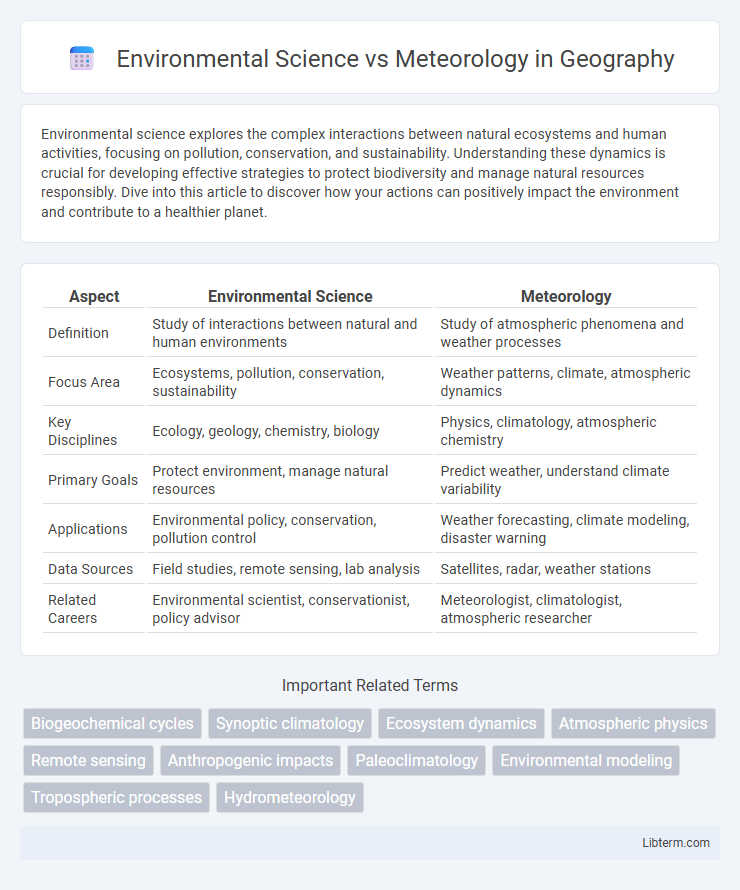Environmental science explores the complex interactions between natural ecosystems and human activities, focusing on pollution, conservation, and sustainability. Understanding these dynamics is crucial for developing effective strategies to protect biodiversity and manage natural resources responsibly. Dive into this article to discover how your actions can positively impact the environment and contribute to a healthier planet.
Table of Comparison
| Aspect | Environmental Science | Meteorology |
|---|---|---|
| Definition | Study of interactions between natural and human environments | Study of atmospheric phenomena and weather processes |
| Focus Area | Ecosystems, pollution, conservation, sustainability | Weather patterns, climate, atmospheric dynamics |
| Key Disciplines | Ecology, geology, chemistry, biology | Physics, climatology, atmospheric chemistry |
| Primary Goals | Protect environment, manage natural resources | Predict weather, understand climate variability |
| Applications | Environmental policy, conservation, pollution control | Weather forecasting, climate modeling, disaster warning |
| Data Sources | Field studies, remote sensing, lab analysis | Satellites, radar, weather stations |
| Related Careers | Environmental scientist, conservationist, policy advisor | Meteorologist, climatologist, atmospheric researcher |
Introduction to Environmental Science and Meteorology
Environmental Science examines the interactions between the physical, chemical, and biological components of the environment, emphasizing ecosystems, pollution control, and sustainability. Meteorology focuses on atmospheric processes and weather patterns, utilizing data from satellites and radar to forecast climate and severe weather events. Both fields employ scientific principles but differ in scope, with Environmental Science addressing broader ecological systems while Meteorology specializes in atmospheric phenomena.
Key Differences Between Environmental Science and Meteorology
Environmental Science encompasses the study of ecosystems, pollution, and natural resources, focusing on the interactions between humans and the environment, while Meteorology specializes in atmospheric phenomena, weather patterns, and climate forecasting. Environmental Science integrates biology, chemistry, and geology to address ecological sustainability, whereas Meteorology relies heavily on physics and mathematics to analyze weather systems and atmospheric changes. The practical applications of Environmental Science often target conservation and environmental management, contrasting with Meteorology's emphasis on weather prediction and climate monitoring.
Core Concepts in Environmental Science
Environmental Science centers on the study of ecosystems, biodiversity, pollution, and sustainable resource management, emphasizing the interaction between humans and the natural environment. Core concepts include biogeochemical cycles, energy flow through ecosystems, and human impact on climate and habitats. In contrast, Meteorology primarily focuses on atmospheric processes, weather patterns, and climate dynamics.
Fundamental Principles of Meteorology
Meteorology centers on the study of atmospheric processes, emphasizing fundamental principles such as thermodynamics, fluid dynamics, and atmospheric physics to understand weather patterns and climate systems. Environmental science encompasses a broader scope, integrating meteorology with ecology, chemistry, and geology to address interactions between the atmosphere and Earth's ecosystems. Key meteorological concepts include air pressure, temperature gradients, humidity, and energy transfer, which are essential for weather forecasting and climate modeling within the environmental sciences.
Study Scope: Environmental Science vs Meteorology
Environmental Science encompasses a broad study scope involving ecosystems, biodiversity, pollution, and natural resource management, integrating biology, chemistry, and geology to understand environmental processes and human impacts. Meteorology focuses specifically on atmospheric phenomena, weather forecasting, climate dynamics, and atmospheric physics, using data from satellites, weather stations, and climate models to analyze short-term weather patterns and long-term climate trends. The scope of Environmental Science is multidisciplinary and holistic, while Meteorology concentrates primarily on atmospheric conditions and weather-related phenomena.
Career Paths in Environmental Science and Meteorology
Career paths in environmental science encompass roles such as environmental consultant, conservation scientist, and sustainability specialist, focusing on ecosystem management, pollution control, and resource conservation. Meteorology offers careers like weather forecaster, climate analyst, and atmospheric researcher, specializing in weather prediction, climate modeling, and severe weather risk assessment. Both fields require strong analytical skills and offer opportunities in government agencies, private sector firms, and research institutions dedicated to environmental and atmospheric study.
Research Methods in Both Fields
Environmental science research methods emphasize interdisciplinary approaches combining field observations, laboratory experiments, and remote sensing to assess ecosystems and human impact. Meteorology relies heavily on satellite data, radar technology, and atmospheric modeling to analyze weather patterns and predict climate changes. Both fields utilize statistical analysis and data integration but differ in spatial and temporal scales of study.
Impact on Global Environmental Issues
Environmental science examines global environmental issues by integrating biology, chemistry, and geology to address climate change, pollution, and biodiversity loss through sustainable resource management. Meteorology focuses on atmospheric phenomena and weather patterns, providing critical data for understanding climate dynamics, predicting extreme weather events, and aiding disaster preparedness. Together, these fields contribute essential insights to mitigate environmental impacts and develop adaptive strategies for a changing planet.
Educational Requirements and Academic Pathways
Environmental Science and Meteorology both require a strong foundation in earth sciences, but Environmental Science typically demands a broader interdisciplinary approach, including biology, chemistry, and ecology, often starting with a bachelor's degree in environmental science or related fields. Meteorology education focuses more on atmospheric sciences, physics, and mathematics, with many meteorologists holding degrees in meteorology, atmospheric science, or applied physics, often advancing to master's or doctoral studies for specialized forecasting or research roles. Both fields offer academic pathways through internships, research projects, and certifications that enhance practical skills and job market competitiveness.
Choosing the Right Field: Environmental Science or Meteorology
Choosing between Environmental Science and Meteorology depends on your interest in studying ecosystems and human impact versus atmospheric phenomena and weather patterns. Environmental Science offers a broad understanding of natural processes and sustainability, while Meteorology focuses specifically on weather forecasting and climate dynamics. Career opportunities vary, with Environmental Science roles in conservation, policy, and research, and Meteorology careers in forecasting, aviation, and climate analysis.
Environmental Science Infographic

 libterm.com
libterm.com